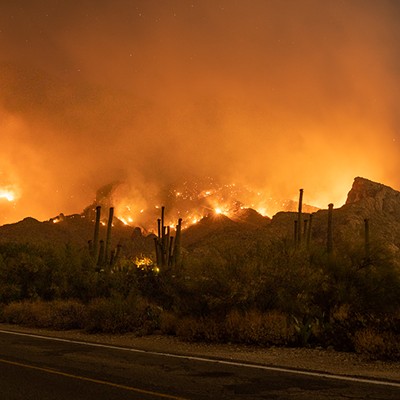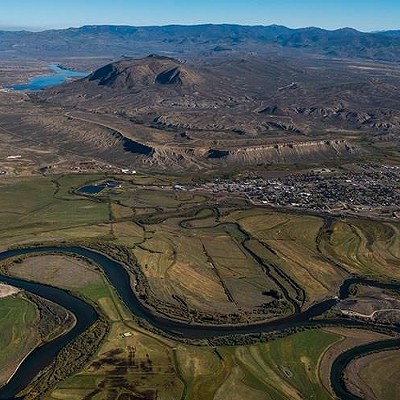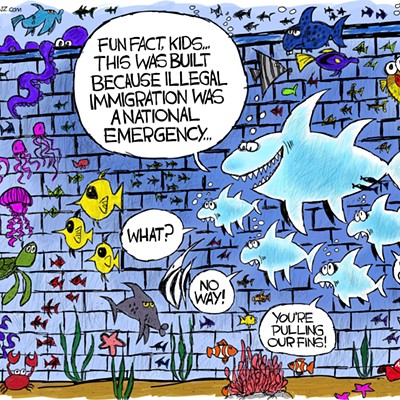Contaminants are emerging as serious issues for drinking-water providers—and Tucson Water officials don't want their latest findings on local contaminants to emerge just yet.
Seven years ago, trace amounts of three emerging contaminants were found in a Tucson Water well near the Santa Cruz River in Marana. Last year, four contaminants were identified as coming from that same well. (See "Drink This!" Aug. 14, 2008.)
As a result, city officials decided to conduct annual testing at a number of sites, including wells north of the sewer-treatment plants on Roger Road and Ina Road and near the city's recharge facilities in Avra Valley.
This year's emerging-contaminant testing was done a few months ago—but Tucson Water representatives have refused to release the results.
"We prefer not to put it out until the issue goes to the mayor and City Council," indicates Tucson Water spokesman Fernando Molina.
A clue to the findings, though, is contained in a September 2009 report on water quality prepared by city and county staff. "The most recent sampling (summer 2009) detected several constituents at a variety of wells and locations," it says.
That would mean more than one well has now been shown to contain measurable amounts of emerging contaminants.
The most likely candidate is a well in relatively close proximity to the originally identified well. Serving the Marana area, these two wells are considered "critical" to the northwest area's water supply.
However, the very low levels of contamination are not currently thought to be a health hazard by authorities, including the federal Environmental Protection Agency (EPA).
"These emerging contaminants have always been there," emphasizes Stephen Dean, interim water quality administrator at Tucson Water, "but we're just seeing them now (because of advanced detection technology)."
Bob Arnold, a chemical and environmental engineering professor at the UA, points out that at least some of the contaminants found in Tucson water are common across the country.
"It's worth watching what goes on," he says. "... If I was living out there (in Marana), I'd ask Tucson Water about it, but still drink the water."
Ben Grumbles, director of the Arizona Department of Environmental Quality (ADEQ), proposes a four-part process to address the issue.
"We need to strengthen the science on pharmaceuticals and personal-care products," Grumbles says, "while improving public understanding. Plus, we should strengthen pollution prevention and product stewardship, and look at opportunities to revise regulations where appropriate."
The four substances found last year by Tucson Water were mostly pharmaceuticals—one of several categories of so-called "emerging contaminants."
Other contaminants coming under scrutiny include endocrine-disrupting compounds (EDC), which "act on the hormonal level in organisms." Personal-care products, trace metals and perchlorate, a component of rocket fuel, are also emerging as items of interest.
Jon Chorover, a professor of environmental chemistry at the UA and the co-director of the Arizona Laboratory for Emerging Contaminants, thinks it's important to know what is being found. However, he also stresses that everything so far detected has been found in extremely low dosages.
"The question is," Chorover asks of all emerging contaminants, "are there any biological signs (of impact)? The answer is probably yes in some cases, and no in others."
Contaminants which interfere with hormones, he believes, could be of concern, pointing out that research has shown that some EDCs can influence the sex of fish. On the other hand, Chorover thinks pharmaceuticals and personal-care products probably shouldn't be of concern.
Pima County Regional Wastewater Reclamation Department (PCRWRD) representatives don't like to acknowledge that their two large treatment facilities are a source of these emerging contaminants. Tucson Water officials, though, aren't so hesitant, concluding: "They're mostly effluent derived."
In any case, Pima County is taking steps to address the issue of emerging contaminants. First, they are spearheading the formation of a pharmaceutical take-back program.
Even though the effort is in its infancy, if it is established, it will be one of only a few such programs in the nation, according to Jeff Prevatt, regulatory compliance manager for PCRWRD.
The idea, Prevatt says, is that instead of people flushing unused prescription drugs down the toilet, officials would collect them at drop-off spots. Those drugs would then be turned over to the federal Drug Enforcement Agency for destruction, thus reducing pharmaceuticals in the sewer system.
On a much larger scale, the county is also acting to directly address EDCs. According to a study done several years ago, the Ina Road facility—and especially the Roger Road facility—do a poor job of handling these contaminants compared to newer, smaller treatment plants in the area.
"The technology in ROMP (the Regional Optimization Master Plan) will go much further in eliminating their impacts," says PCRWRD spokeswoman Laura Hagen Fairbanks.
PCRWRD director Mike Gritzuk says the ROMP program will allow the Roger Road treatment plant to be replaced with one that uses a Bardenpho-activated sludge process. The Ina Road facility, he adds, will also be improved to totally utilize this process.
The project is estimated to cost $720 million; a $440 million ROMP phase could be included as part of a 2010 county bond package.
However, even after implementation of the Bardenpho process, Gritzuk assumes more will have to be done to deal with emerging contaminants once the EPA establishes drinking-water standards for any of them.
"After Bardenpho," Gritzuk says, "something else will have to be added, such as membranes or disinfection. We won't know until the standards come out."












